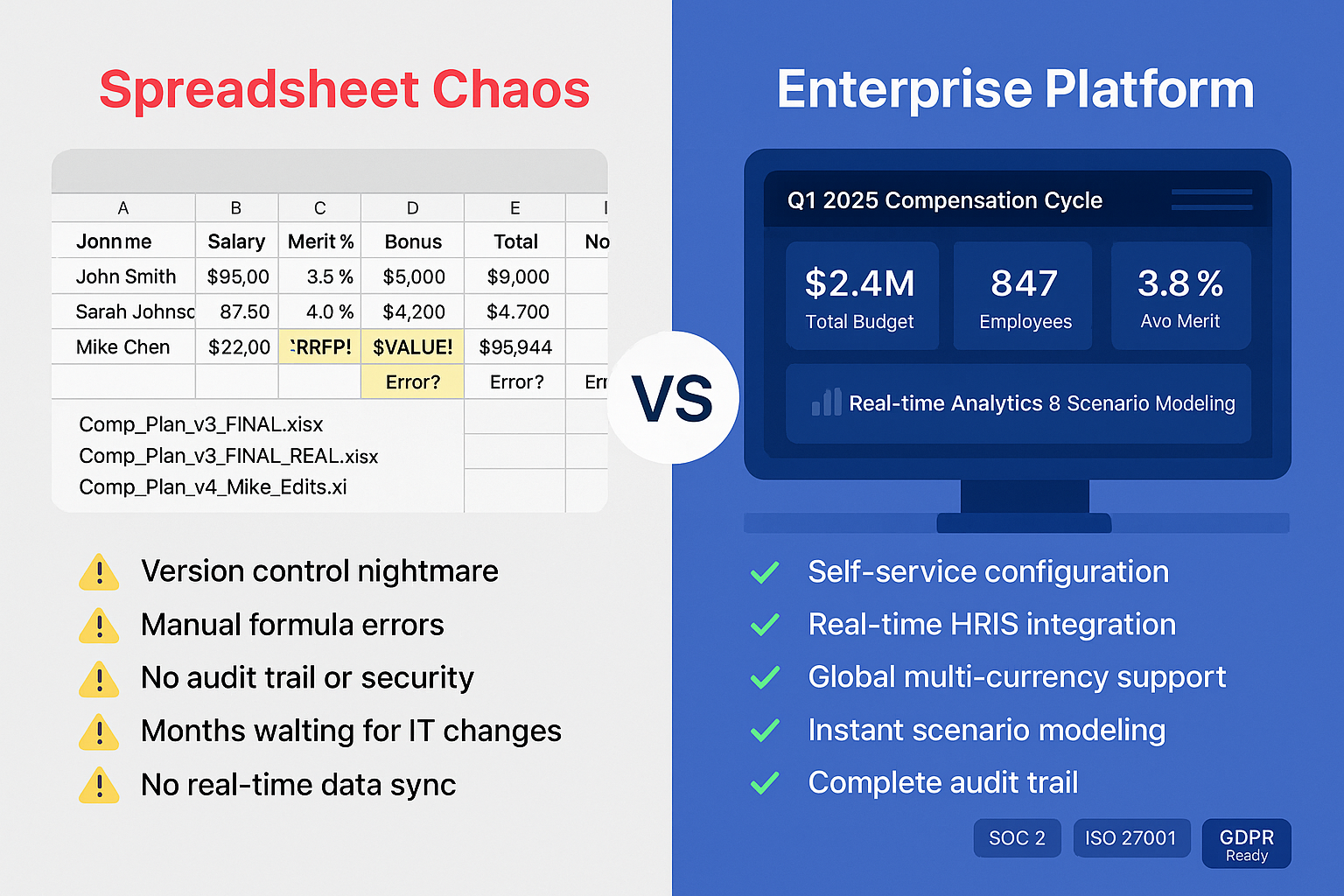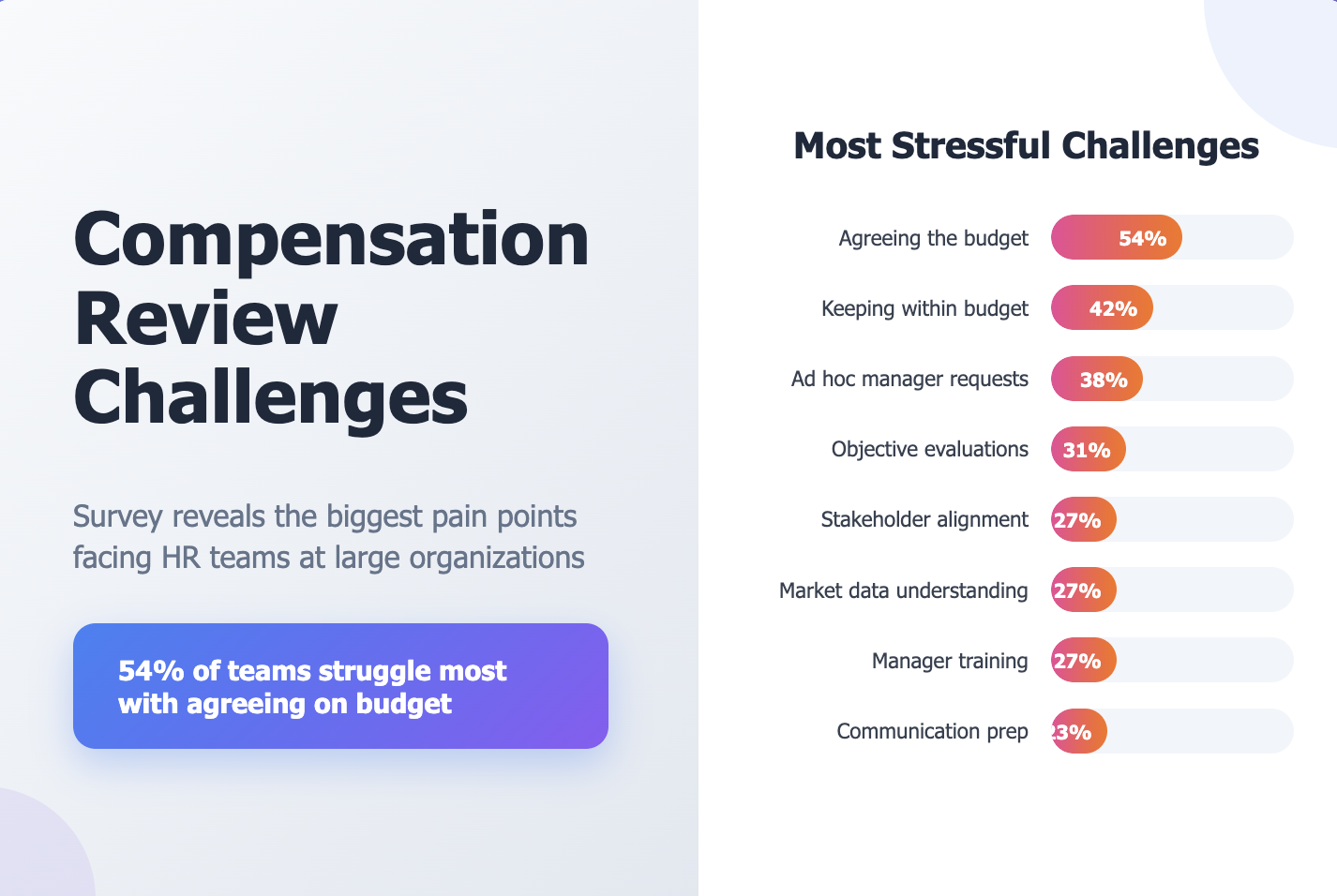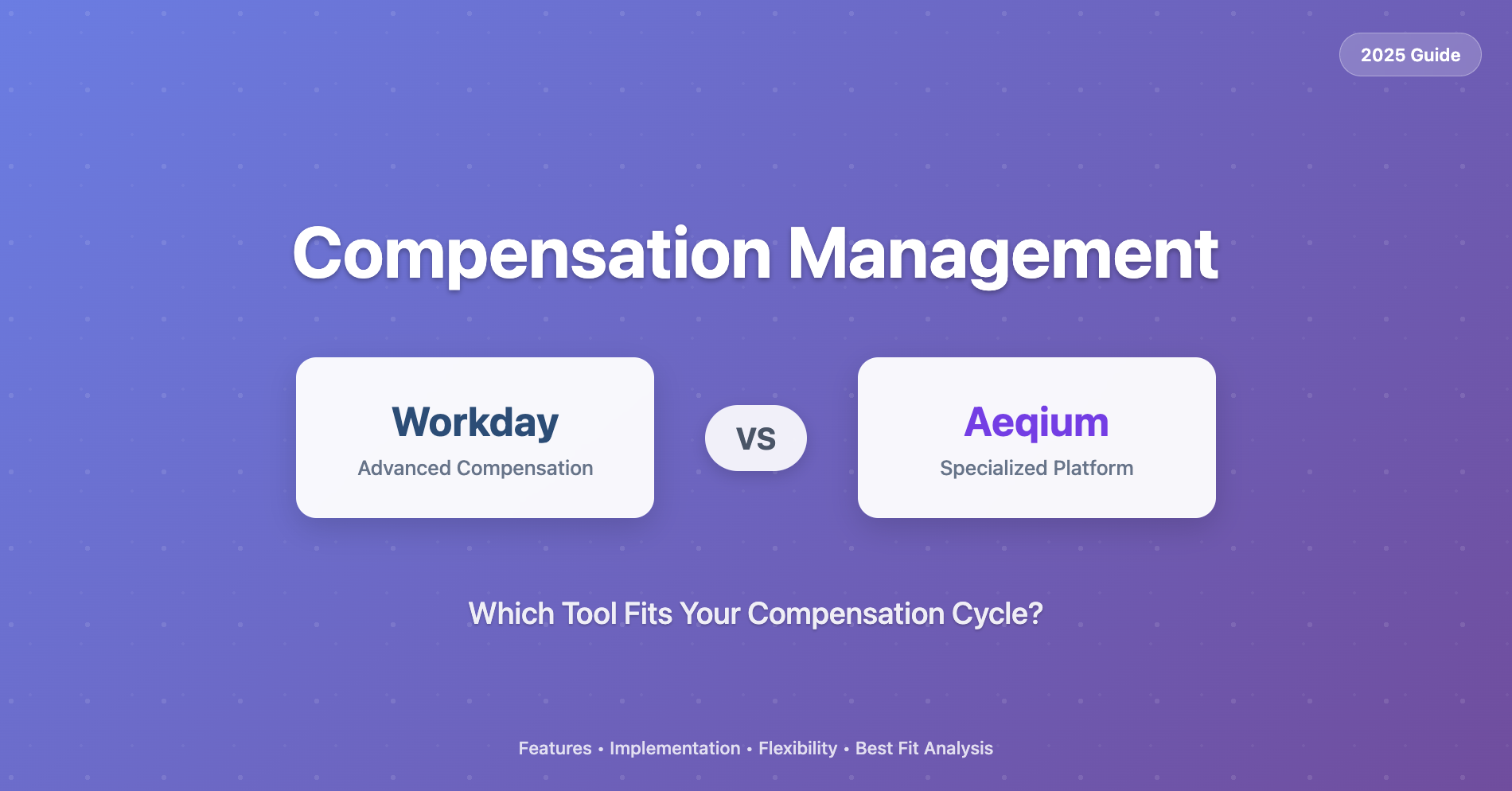6 Criteria for Enterprise Compensation Platforms

The Spreadsheet Trap
Enterprise HRIS and HCM platforms are powerful, but they're also so complex that only specialized IT or HRIS teams can make changes. That leaves HR and Rewards leaders waiting in line for weeks or even months. And when the business can't wait, they fall back on spreadsheets.
Spreadsheets are flexible, but risky. They introduce errors, lack security, and can't scale. Yet they persist because they let HR act when centralized systems move too slowly.
The real challenge compensation planning tools and compensation management software must address isn't just replacing spreadsheets. It's giving HR and Rewards leaders real-time control over their cycles without being blocked by IT.
Why Enterprises Still Fall Back to Spreadsheets
Enterprises often invest heavily in "all-in-one" platforms because centralization looks efficient on paper. But centralization comes with a trade-off: configurability is so technical that HR leaders cannot manage cycles without IT.
That creates a bottleneck. Cycles drag on, last-minute adjustments stall, and Rewards leaders feel powerless. Spreadsheets step in because they provide flexibility. But that flexibility comes at the cost of:
- Version control problems: no single source of truth
- Manual errors: formulas and macros that break at scale
- Security risks: sensitive data in unsecured files
Spreadsheets persist not because they're the best option, but because they allow HR to move when enterprise systems don't.
The 6 Criteria for Evaluating Compensation Planning Tools
When evaluating solutions, look past feature checklists and focus on whether the platform gives HR leaders control. These six criteria should guide your evaluation.
1. Configurability Without IT
The first test is simple: can your Rewards team make changes without opening a ticket? A modern tool should allow HR to:
- Edit eligibility rules on the fly
- Add or adjust bonus pools mid-cycle
- Run last-minute merit or equity refreshers
- Reconfigure cycle structures themselves
If IT still controls the system, your team will default back to spreadsheets.
2. Security and Compliance Standards
Enterprises cannot compromise on security, but compliance must not mean losing usability. The right compensation planning software should provide:
- SOC 2 and ISO 27001 certifications
- Role-based permissions so managers only see what they should
- Audit trails for every change
- GDPR compliance and configurable pay-range disclosures to meet U.S. and EU mandates
The goal is secure control, not security that locks HR out.
3. Real-Time Integrations
Compensation planning is only as accurate as the data behind it. The platform should integrate with HRIS, payroll, performance management, and equity systems in real time. That prevents:
- Outdated salary data in cycle planning
- Manual copy-paste between systems
- Managers making decisions on stale information
Look for APIs that sync instantly, not batch uploads that update once a week.
4. Scenario Modeling and Analytics
One of the biggest advantages of compensation management software is instant modeling. Enterprises should expect:
- What-if modeling for merit increases and bonus scenarios
- Budget allocation models (top-down, bottom-up, centralized, distributed)
- Currency exchange impact for global teams using live FX rates
- Equity dilution modeling to assess shareholder impact
- Vesting and refresher tracking for LTIPs
- Pay equity analysis to identify gaps across gender, race, or location
If HR can't model scenarios themselves, they'll go back to Excel.
5. Scalability for Global Teams
A compensation planning tool must scale with global workforces, including:
- Multi-currency support with real-time FX conversion
- Localization for taxes, benefits, and labor laws
- Compliance alerts for region-specific triggers
- Flexible cycle structures across geographies
If it only works in one market, it's not enterprise-ready.
6. Speed to Value
Finally, even the most powerful system fails if it takes too long to implement. The right tool should:
- Go live in weeks, not quarters
- Provide intuitive dashboards HR can use without training
- Include hands-on support during early cycles
If deployment drags on for months, HR leaders will return to spreadsheets before the platform even launches.
How Control Translates Into Business Impact
When HR and Rewards teams gain real-time control, the results are immediate:
- Pay equity: faster audits and corrections reduce risk and build trust
- Transparency: live total rewards statements give employees clarity
- Retention: better communication strengthens engagement and lowers turnover
- Efficiency: HR stops waiting in IT queues and spends more time on strategy
As Sally Knill, Global Head of Reward at IFS, put it:
"We brought the whole process down to a month and it had taken nearly double that originally... And the ease of pulling the data out was just amazing... What would have taken me a day to produce for the final sign off took me about half an hour."
Control isn't just about convenience. It's about fairness, compliance, and competitiveness in how organizations reward their people.
Key Questions to Ask Vendors
Before selecting a platform, press vendors on whether they:
- Allow HR to make last-minute changes without IT
- Can implement in weeks, not quarters
- Replace spreadsheets fully (or still rely on exports to Excel)
- Support U.S. and EU pay-transparency mandates
- Offer multiple budgeting models (top-down, bottom-up, centralized, distributed)
- Manage live currency exchange and equity vesting in the same dashboard
- Provide real-time integrations rather than batch data
These questions separate platforms that look good in demos from those that work in practice.
Moving Beyond the Spreadsheet Problem
The spreadsheet problem isn't really about Excel. It's about control. Enterprises need compensation planning tools that give HR leaders autonomy while still meeting enterprise standards for security, accuracy, and compliance.
When measured against the six criteria above, most platforms fall short in at least one area. Aeqium was built to close those gaps. It provides the configurability HR teams need, with enterprise-grade security, real-time integrations, advanced modeling, global scalability, and fast implementation.
For enterprises ready to move past spreadsheets and run cycles with confidence, Aeqium is a platform worth considering.




